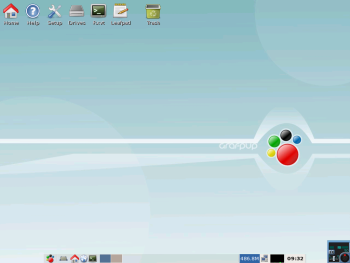Author: Preston St. Pierre
Grafpup 2.0 is a compact Linux distribution based on Puppy Linux and aimed at graphics professionals. It offers a variety of options for installation, a custom set of configuration utilities, and a niche suite of applications for digital artists. The graphics are soothing, and the Openbox desktop runs smoothly even on older hardware. Despite a few problems, Grafpup is a good choice for graphic designers and writers on the go.
Grafpup offers several ISO versions, ranging in size from 67MB for a version with the Dillo Web browser to 114MB for one with the full Mozilla Seamonkey suite. I chose the Seamonkey version because I like Firefox and don’t care about the increased size.
Bootup time from the live CD was slightly better than Knoppix on the same machine, an old Celeron 1.5GHz with 512MB of memory, but the difference was not as much as I’d have expected given the relative sizes of the two distributions. The settings that I had changed on a previous boot were automatically detected and reassigned, though, saving me some extra time. Performance was good. I tried booting Grafpup on two Athlon systems with different Nvidia graphics cards and peripherals, and the hardware was properly detected on both.
Installing Grafpup to the hard drive was simple. The System Installer option in the System section of the main menu brings up an easy-to-use wizard that offers a variety of choices on how to install Grafpup, ranging from the traditional full partition install to USB keys to a frugal install that can coexist with other distributions on the same partition. I chose the frugal install, which copied files to the hard drive without error in just a few minutes. Once it came time for the installer to add Grafpup to the GRUB configuration file, though, a popup message informed me that the GRUB configuration file could not be edited. Luckily the installer also told me what it was trying to write, so I copied down the configuration and added it manually. The whole process took about 10 minutes.
Once I had booted to my fresh Grafpup install, my first order of business was to change the root password, delete the grafpup user, and add a user of my own. I used the regular adduser command to add my new user, but Grafpup refused to log in as the new user, claiming “Failed to execute login command.” I tried logging in as root and adding a user with the Grafpup Setup tools. This time everything worked properly and I could log in.
I soon discovered that not only was my favorite editor, nano, missing, but so was vi. Vim is likely the most common text editor, certainly an essential tool, and is included in every other distro I’ve tried. After a bit of searching with Google I found that the developer’s solution to the text editing problem is to use Midnight Commander’s text editor, mcedit. That’s a questionable decision. The latest release of Vim takes less than 7MB of space, including source files, and the other recent releases are just as usable and half the size.
Other than missing Vim, I was not disappointed by the selection of programs available, even for such a small ISO. By including applications of primarily one kind, Grafpup cover its niche well while still maintaining an efficient download. The included programs target audio playing, editing, ripping, and encoding; ISO creation; CD/DVD burning; text editing and publishing; and image creation and manipulation, both vector and bitmap, still and animated. Grafpup uses dcraw and ufraw to support almost all raw image files. It handles digital cameras via gtkam. For artwork, it includes the GIMP, CinePaint, mtPaint, and Inkscape. Text manipulation is handled by Scribus and Abiword, while audio is covered by PawdioConverter, Sox, and PBcdripper. Video ripping can be accomplished through pupdvdtool.
Seeing how easy pupdvdtool made ripping and encoding DVDs, I decided to try it on a few of the movies I’ve been meaning to copy to my hard disk. I was able to rip them and shrink the resulting files without problem. Having been successful at trying the process in one direction, I attempted to create a DVD from one of my movies. The pupdvdtool allowed me to convert the file to the proper format, add chapters and a name, then burn it. It played on my computer, but alas, my DVD player would not read it. I suspect the fault lies with the DVD player and not the tools used.
Grafpup’s audio editing tools are decidedly limited. Users can add a few minor effects to audio files, but the distribution’s focus is on ripping, encoding, and burning. If you do extensive audio editing, try instead a live CD such as dyne:bolic.
Almost everyone knows of the GIMP, a powerful bitmap editor, and most people are also familiar with the vector-based Inkscape. Both are wonderful programs and would alone cover most aspects of graphics editing. CinePaint is a fork of the GIMP that allows you to use frames to create or work with video. mtPaint is an editor meant for creating icons and pixel art.
While I encountered a few problems when working with Grafpup, they were generally easy to solve, and my overall impression of the distribution is good. It seems to cover all the aspects of digital graphics editing and publishing that the majority of people would need, and does so with elegance and without bloat. If you fit the target user group, give it a try. I doubt you’ll be disappointed.
Categories:
- Grafpup
- Reviews
- Linux
- Distributions




